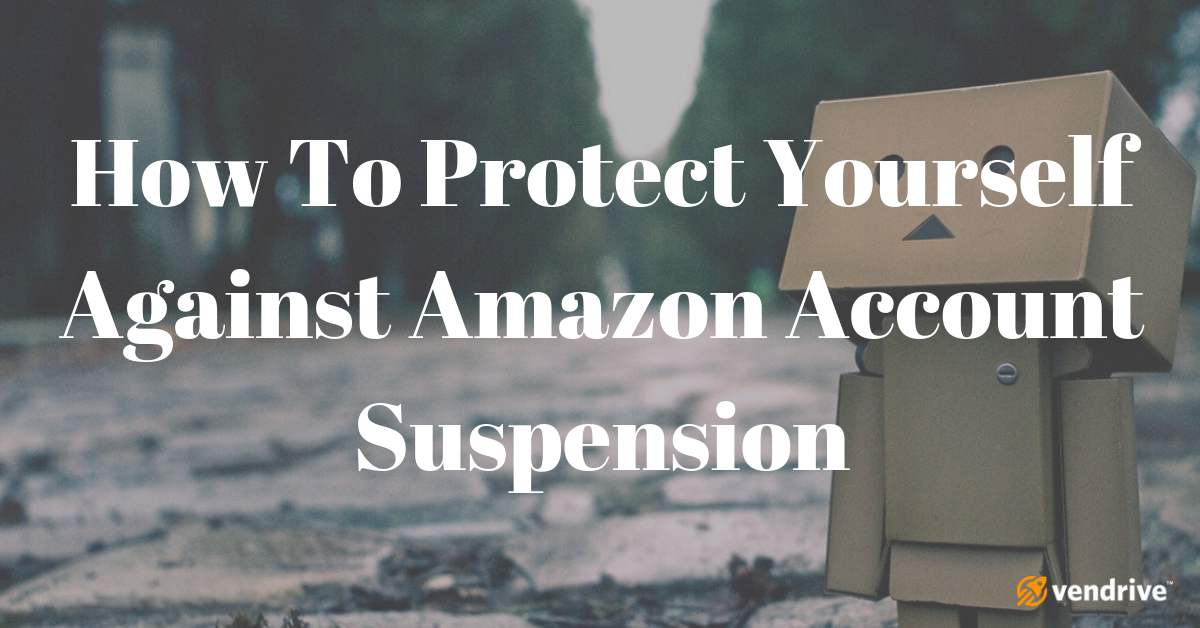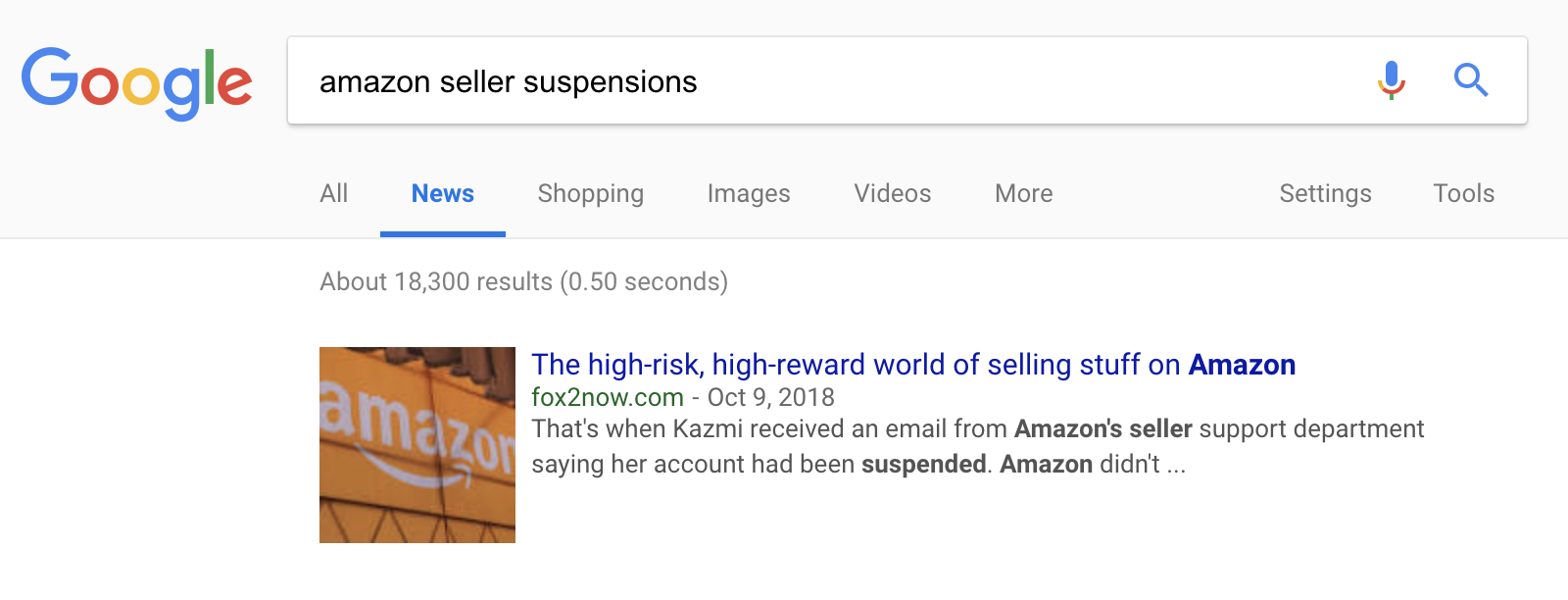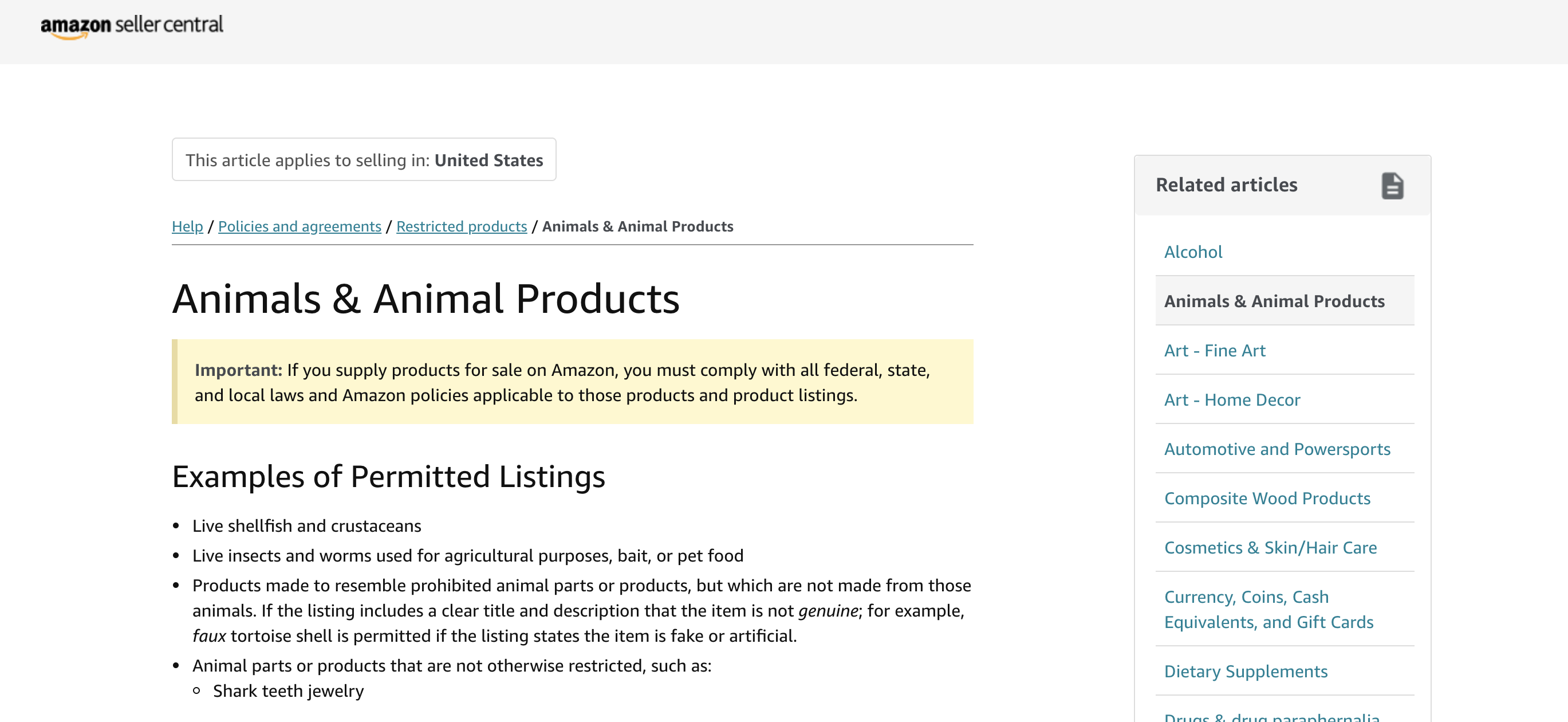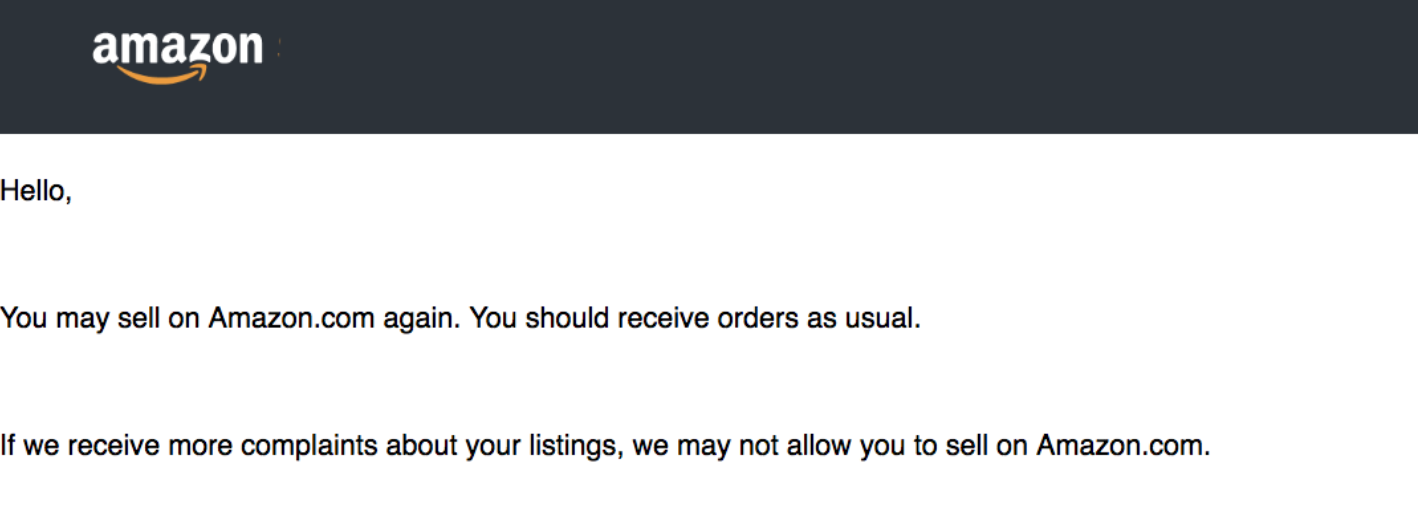
Amazon account suspension is a very real thing. Every day, hundreds of honest sellers are falling victim to it. However, as usual, the internet is also full of misconceptions – let’s clear a few things up.
You might have seen on social media that Amazon account suspensions are becoming more frequent. In ways, that very much is the case. On the other hand, it’s not why you may think.
Amazon is continuously improving their marketplace to be the best it can be. What does that mean? Being stricter about the sellers on its platform.

How Amazon wants its customers to feel with each order
Think about it from a buyer’s point of view. The buyers are where Amazon’s revenue really comes from, so of course, they’re going to want the best service. Wouldn’t you?
If the buyer has a bad experience via an Amazon seller, it isn’t the seller that gets the bad phone call – it’s Amazon.
And so, it goes without saying that they’d want to uphold their brand’s high standards. But where does that leave us, honest sellers, seemingly banned for no reason?
How Amazon account suspension affects its sellers
For pretty much every full-time seller, Amazon revenue is a huge part of their income. Therefore, an account suspension can deal a massive blow to their reputation and, more importantly, wallets.
Every minute a seller is suspended, they’re actively losing money from more than 2 billion users.
Needless to say, it’s more-than-fairly stressful.
Hundreds of sellers are faced with the worry of being denied, banned, or suspended from Amazon every day.
This could be for any reason: policy violations, Code of Conduct violations, suspected bad behavior, and even poor metrics.
To be the best marketplace out there, Amazon simply has to be strict.
You see, the thing is, even the best of Amazon’s sellers have been suspended.

This could be due to the dozens of misconceptions out there about Amazon’s suspension policies. We don’t blame whoever kickstarted them. If anything, we understand.
Receiving a suspension can be ego-crushing, confusing, and then some.
These misconceptions can actually be hurtful to the process. They can also ruin your chances of having your account reinstated, which is the exact opposite of what you want.
If your Amazon account has been suspended, you can have your privileges restored by submitting an appeal as soon as possible. Understanding the suspension/reinstation process puts you dozens of steps ahead of if you were to believe the next myth that pops up on your Facebook feed.
When it comes down to it, the only realistic way to deal with an Amazon account suspension is to submit an appeal.
Show Amazon that you understand why you were suspended and have a plan of action to rectify the issue.
Dispelling those all-too-common myths
Myths are rife. As an Amazon seller, you probably already know that.
For example, one myth is that Amazon will suspend you if you alert them of your issues or not, which is completely false.
MYTH: “I can avoid account suspension if I delete the problem item.”
FACT: Deletion only results in drawing more of the bad kind of attention to yourself.
INSTEAD: Respond to the warning email letting Amazon know you’re aware of the problem and tell them what you plan to do to rectify it.
MYTH: “My complaint will be seen to faster if I know someone who works at Amazon.”
FACT: There are so many departments behind Amazon, there’s a good chance your contact wouldn’t be able to do anything anyway.
INSTEAD: While it helps to know someone at the company, you do have to make sure you know the right someone. Carefully researching whether they can help or not will save you time in the long run.
MYTH: “If I respond to Amazon’s emails, they’ll take my shop down.”
FACT: To be honest, Amazon doesn’t have the time. Your business is also more important to you than it is to them. Notifying them will kickstart the process much faster.
INSTEAD: Think of this as you would your banking. Not checking your balance never ends well. Instead of avoiding contact with Amazon, contact them with the improvements you’re going to make to rectify the problem or prevent suspension.
Remember: Myths are only good in fairy tales, and you can’t chance a misconception when your livelihood is up for debate.
Why was my account suspended?
The more premiere the marketplace becomes, the stricter Amazon gets with its rules and regulations. This is in order to prevent their marketplace from becoming like others, those marketplaces where everything and anything goes.
Amazon wants high standards for its customers – as a seller, I’m sure you get that, too.
With that taken into account, there are a lot of reasons why your Amazon seller account has been or may be suspended. They also aren’t irrational reasons – each one of them has its own understandable reason for existence.
In the process of rectifying a suspension, you first need to know why you were suspended.
You can find this in the notification email that Amazon will have sent to you OR by checking your Performance Notifications in Seller Central.
Reasons for your Amazon account suspension
Possible reasons for your suspension can be anything from poor performance ratings to odd activity. Brushing up on this is the best way to start the appeals process.
1 – Performance quality
If your notice mentioned POOR PERFORMANCE, this is to do with your metrics and whether or not they’re meeting Amazon’s targets.
Check your ACCOUNT HEALTH DASHBOARD to see which of them aren’t matching up to Amazon’s standards. Although the notification email should indicate what the performance issue is, it will still do you good to check the exact amounts.
2 – Seller policy violations
Consider whether your selling practices are consistent with the community rules that are stated by Amazon. Although the rules are quite broad, with thorough examination you should be able to consider how your practices may or may not fall under each of the guidelines.
Amazon’s goal is to provide a safe and enjoyable experience for its buyers, which means clear rules for sellers. There are five rules a seller must abide by:
1 – Honoring your commitment to buying or selling
2 – Maintaining current account information and ensuring it’s up to date
3 – Not opening a second selling account if/when your privileges have been limited or removed
4 – Leaving thoughtful feedback on your transaction partners
5 – Not misrepresenting yourself – as in faking your identity, because that happens
3 – Product rule violations
Check your inventory and inventory intake. If the notice suggested violations of product rules, you’ll need to check your inventory and the inventory intake. This will help you to determine which parts of your supply are prohibited or up for removal. Amazon may even indicate the prohibited item in the notice.
If they do, you won’t have to check your inventory for yourself.
Amazon measures its performance targets over three metrics: order defect, pre-fulfillment cancel rate, and late shipment rate. In short, this means the following:
• Order defect rate: percentage of orders that have received negative (one or two-star ratings) feedback, a buyer reporting an issue with their order, or when a buyer disputes your order as a credit card purchase. Amazon recommends that sellers maintain an order defect rate of <1%
• Pre-fulfillment cancel rate: number of order cancellations initiated by the seller prior to confirmation of shipment divided by the total number of orders over the same period. High pre-fulfillment rates are generally a result of poor inventory management. Amazon recommends that sellers maintain pre-fulfillment cancellation rates of <2.5%
• Late shipment rate: number of orders confirmed for shipment after the initial shipment date divided by the number of orders in that same period. High late shipment rates = customer dissatisfaction. (As you know by now, this is definitely not what Amazon is about).
4 – Violations of restricted product rules
Instead of having only one set of product rules, Amazon has its own specific product restrictions for each of their product categories. This ensures that resale accounts if they are within their rights to sell, don’t get swept up in the flurry of products that are restricted.

Looking at Amazon’s Restricted Product pages can help you to make sure your supply is appropriate.
How to prevent or remedy an account suspension
Acting now and quickly is the number one preventative way to circumvent Amazon account suspension. Additionally, Amazon gives you only 17 days in which to submit your appeal.
As any doctors over the past 20 years would tell you, prevention is also better than finding a cure.
If Amazon sends you a notice or a warning, fix it immediately, and tell Amazon what you’re doing to rectify the situation as we talked about earlier. Then, write a successful appeal with a clear plan of action, and submit it to Amazon Seller Performance.
This will help you to regain Amazon’s trust.
Plan of Action
Your plan of action should detail how you expect to improve the issues that led to your suspension. It’s also incredibly important to put time and effort into your submission, as there’s no guarantee that Amazon will give you a second opportunity.

Our tips for writing a successful plan of action are as follows:
• Introduce yourself in a short opening paragraph
• Stay professional, not informal
• Don’t pull the superiority card – Amazon employees are trained to know the company policies
• Do not tell them what to do
• State your facts simply, with bullet points as opposed to paragraphs
• Most importantly: do NOT blame your buyers
Furthermore, you should always identify the reasons behind your suspension. Take responsibility for the missteps and acknowledge that your actions caused harm to the customer.
You should also tell them that you’re fully committed to providing exceptional customer service and that you understand that selling on the Amazon marketplace is a privilege, not a right.
Here are some of the things you should do differently next time – and tell them as such in your appeal:
• Keep an eye on what customers are saying about you
• Communicate openly with your buyers
• Label your products correctly (new products as “new”, used products as “used”)
Tip: Downloading the Amazon Seller app is great for customer communication and interaction. Show them – and Amazon – that you care.
In closing, while submitting your appeal and plan of action won’t guarantee that your account is reinstated, a thorough investigation into why you may have been suspended will also show that you care about being a part of the Amazon family.
And, in order to do that, you need to adhere to Amazon’s high standards in order to continue selling on the marketplace.
Put it this way: Amazon treats its buyers well – why wouldn’t you want to continue being part of that?






About The Author: Dillon Carter
Hi, with James, we're building Amazon tools that we wish we had when starting our own companies. We love tech, coffee, building systems and all things Amazon.
More posts by Dillon Carter